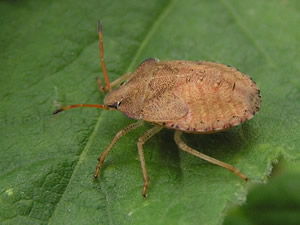| |
|
| |
Handy Guide to Bugs: Hemiptera - True Bugs |
| | |
| While many people refer to all insects as "bugs" those of Hemiptera are called "True Bugs" and there are over 50,000 species around the world. |
| | |
 |
| These bugs have two sets of wings with the front pair being leathery at the base and transparent at the tip which can be clearly seem in this image of a Green Stink Bug, Banasa sp, above. In fact, "Hemiptera" means "half wings" in Greek. |
| | |
| Another characteristic of this order is that they don't have mouths for chewing and biting but instead have sharp, beak-like mouthparts which are tucked under the insect's "chest" or "chin" when not in use. Some use these sharp beaks to suck on plant juices while others choose the body fluids of other insects of animals - including humans. |
| | |
|
 |
|
 |
Pentatomid |
|
Shield Bug, Elasmostethus cruciatus |
| |
|
| |
 |
|
 |
Shield Bug, Elasmostethus cruciatus |
|
Green Stink Bug |
| |
_ |
| |
 |
|
 |
Spit Bug |
|
Chlorochroa Nymph, family Pentatomidae |
| |
|
| |
 |
|
 |
Philaenus Spumarius |
|
Stink Bug Euschistus |
| |
|
| |
 |
|
 |
Neacoryphus lateralis |
|
Water Strider, Gerris remigis |
| |
|
| |
| This diverse order includes the water striders - those bugs you see skimming across ponds and lakes - and stink bugs which have scent glands that excrete a nauseating smell when threatened. |
|
|
|
|













